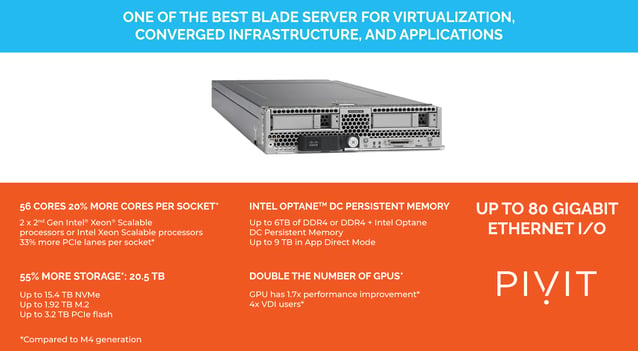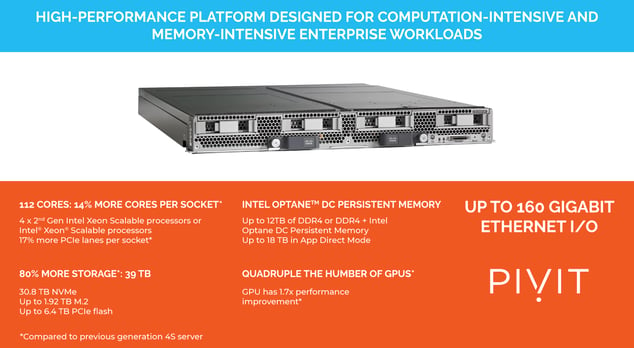Cisco UCS M5 Server Comparison: B200 M5 and B480 M5
-Nov-22-2021-07-52-34-62-PM.png)
The Cisco UCS (Unified Computing System) is an integrated computing infrastructure with intent-based management to automate and accelerate all your applications, including virtualization and cloud computing. Since the system was first announced, Cisco has joined the top layer of server vendors, with more than 86 percent of Fortune 500 companies investing in Cisco UCS. The system has set more than 150 world performance records—all serving as a testament to leadership and dedication to customer-centered innovation.
Cisco UCS B-Series Blade Servers provide massive amounts of computing power in a compact form factor, helping to boost density in computation-intensive and enterprise application environments. Cisco’s blade servers are available in two form factors (half- and full-width) with two or four 2nd Gen Intel Xeon Scalable processors. They work with virtualized and non-virtualized applications to increase performance, energy efficiency, flexibility, and administrator productivity. Cisco UCS's available blade servers are Cisco UCS B200 M6, Cisco UCS B200 M5, and Cisco UCS B480 M5.
This article provides an overview and comparison of the Cisco UCS M5 blade servers to make a decision on whether to implement such a system into your existing network infrastructure.
UCS B200 M5 Blade Server Overview
For data centers, cloud, or remote sites, the enterprise-class Cisco UCS B200 M5 Blade Server delivers market-leading performance, versatility, and density without compromising workloads ranging from web infrastructure to distributed databases. This enterprise-class server also offers converged infrastructure, Virtual Desktop Infrastructure (VDI), and enterprise applications such as SAP HANA and Oracle.
The Cisco B200 M5 server can rapidly deploy stateless physical and virtual workloads through programmable Cisco UCS Manager and Cisco Intersight and simplified server access by Cisco SingleConnect technology.
UCS B200 M5 Blade Server Key Features
The Cisco UCS B200 M5 is a half-width blade server. Up to eight servers can reside in the 6 RU Cisco UCS 5108 Blade Server Chassis, which is one of the highest densities of servers per rack unit of blade chassis in the industry. You can configure the B200 M5 to meet your local storage requirements without buying power and cooling components that you do not need.
The Cisco UCS B200 M5 gives the below key features:
- 2nd Generation Intel Xeon Scalable processors with up to 28 cores per socket.
- Up to 3 terabytes (TB) of DDR4 memory for improved performance.
- Up to 7.5 terabytes (TB) using 12x128G DDR4 DIMMs and 12x512G Intel Optane DCPMM nonvolatile memory technology.
- Up to two NIVIDA GPUs.
- Two Small-Form-Factor (SFF) drive slots.
- Up to two Secure Digital (SD) cards or M.2 SATA drives.
- Up to 80 Gbps throughput.
- Support one rear storage mezzanine card.
- Support one 16-GB internal flash USB drive.
- Support rear mezzanine VIC with 2 x 40-Gbps unified I/O ports, or two sets of 4 x 10-Gbps unified I/O ports.

UCS B480 M5 Blade Server Overview
The Cisco UCS B480 M5 Blade Server gives a market-leading performance, versatility, and density without compromising mission-critical memory-intensive enterprise applications and virtualized workloads. With the Cisco UCS B480 M5, you can quickly expand stateless physical and virtual workloads with the programmability that Cisco UCS Manager and Cisco SingleConnect technology enable.
Cisco UCS B480 M5 Blade Servers are supported by the full suite of Cisco Unified Computing System (Cisco UCS) management tools and are engineered for Cisco Intersight. Cisco Intersight is a Software-as-a-Service (SaaS) management platform that uses analytics to deliver proactive automation and support. By combining intelligence with automated actions, you can reduce costs dramatically and accelerate time to resolution.
UCS B480 M5 Blade Server Key Features
The Cisco B480 M5 is a full-width blade server supported by the Cisco UCS 5108 Blade Server Chassis. The UCS 5108 chassis and the Cisco B-Series Blade Servers provide inherent architectural advantages.
Here are some of the key features:
- Second-generation Intel Xeon scalable CPUs with up to 28 cores per socket.
- Up to 6 terabytes (TB) memory using 128G DDR4 DIMMs.
- Up to 12 terabytes (TB) memory using 128G DDR4 DIMMs.
- Memory speeds rise from 2666 MHz to 2933 MHz.
- Up to 18 TB using 24x256G DDR4 DIMMs and 24x512G Intel Optane DC Persistent Memory Modules.
- Up to four NIVIDA GPUs.
- Cisco FlexStorage storage subsystem.
- Five mezzanine adapters and support for GPUs.
- Supports Cisco UCS Virtual Interface Card (VIC) 1340 modular LAN on motherboard (mLOM) and upcoming fourth-generation VIC mLOM.
- Supports Internal Secure Digital (SD) and M.2 boot options.
- Up to 160 Gbps throughput.
Now that you have all the technical specs, head over to our products tool to start building a quote for the UCS B480 M5 Blade server.

UCS B200 M5 and UCS B480 M5 Head-To-Head
| Features | B200 M5 | B480 M5 |
| Processors | 2 | 4 |
| Processor Supported | 2nd Gen Intel Xeon Scalable and Intel Xeon Scalable processors | 2nd Gen Intel Xeon Scalable and Intel Xeon Scalable processors |
| Maximum memory | 9 TB with Intel Optane Pmem | 18 TB with Intel Optane Pmem |
| Form factor | Half-width blade | Full-width blade |
| RAID | 0, 1 | 0, 1 |
| Mezzanine I/O adapter slots | Up to 3 | Up to 5 |
| GPUs | Up to 2 | Up to 4 |
| Max I/O throughput per blade | 80 Gbps (2 x 40 Gbps) | 160 Gbps (4 x 40 Gbps) |
| Maximum servers per chassis | 8 | 4 |
| Internal storage | Up to two SAS/SATA/SSD/NVMe | Up to four SAS/SATA/SSD/NVMe |
| Maximum internal storage | 20.5 TB | 39 TB |
The table above depicts the comparison from a technical aspect. To see a price comparison, head to our products tool to start building a quote for a Cisco UCS Blade Server.
Which Server Fits in My Network?
The Cisco UCS B200 M5 and B480 M5 Blade Servers offer excellent performance, flexibility, and I/O throughput to run the most critical applications. It can deliver more data through its 40G link. Users can run many virtual machines using the upgraded CPU, memory, and hard disk.
The Cisco UCS M5 blade series serves excellent candidates for applications such as:
- SAP and SAP HANA
- SQL
- Oracle
- Data warehouse
- Large virtualized environments, including Virtual Desktop Infrastructure (VDI)
- Real-time financial applications
- Java-based workloads
- Server consolidation
For mid-size requirements, it's ideal to go with the UCS B200 M5 server. If you need a faster CPU and more memory, then the UCS B480 M5 is the perfect solution for you. UCS B480 is mainly designed for a large deployment.

